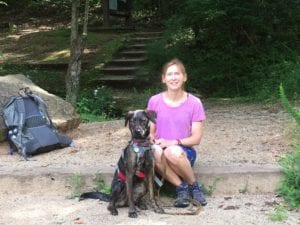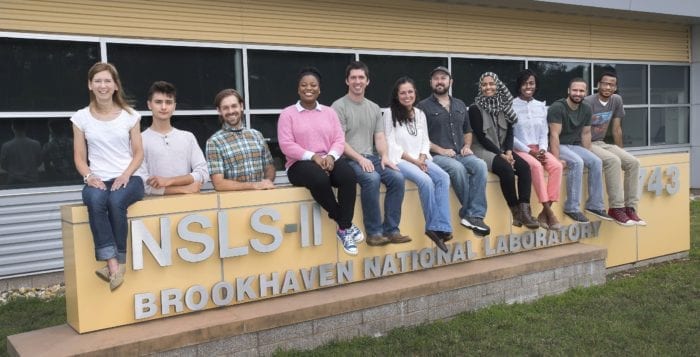By Daniel Dunaief
Most of the people at the building that cost near a billion dollars are pulled in different directions, often, seemingly, at the same time. They help others who, like them, have numerous questions about the world far smaller than the eye can see. They also have their own questions, partnering up with other researchers to divide the work.
Lisa Miller, a senior biophysical chemist at Brookhaven National Laboratory, lives just such a multidirectional and multidimensional life. The manager for user services, communications, education and outreach at the National Synchrotron Light Source II, Miller recently joined forces with other scientists to explore the potential impact of copper on a neurodegenerative disease called cerebral amyloid angiopathy (CAA).
Miller is collaborating with Steve Smith, the director of structural biology in the Department of Biochemistry and Cell Biology at Stony Brook University and William Van Nostrand, a professor in the Department of Neurosurgery at SBU who will be moving to the University of Rhode Island. The trio is in the second year of a five-year grant from the National Institutes of Health.
Miller’s role is to image the content, distribution and oxidation state of copper in the mouse brain and vessels. Van Nostrand, whom Smith described as the “glue” that holds the group together, does the cognitive studies and Smith explores the amyloid structure.
In an email, Smith explained that Van Nostrand’s primary area of research is in CAA, while he and Miller were originally focused elsewhere.
Potentially toxic on its own, copper is transported in the body attached to a protein. When copper is in a particular ionic state — when it has two extra protons and is looking for electrons with which to reduce its positive charge — it reacts with water and oxygen, producing hydrogen peroxide, which is toxic.
Miller and her colleagues are working on a technique that will enable them to freeze the tissue and image it. Seeing the oxidation state of the metal requires that it be hydrated, or wet. The X-rays, however, react with water, causing radiation damage to the tissue.
To minimize this damage, the researchers freeze the tissue. At NSLS-II, a team of scientists are working to develop X-ray-compatible cryostages that will allow them to freeze and image the tissue.
Miller is trying to figure out where and why the copper is binding to an amyloid beta protein. This is the same protein that’s involved in plaques prevalent in the brains of people with Alzheimer’s disease.
In Alzheimer’s patients, the plaques are found in the parenchyma, or the extracellular space around the brain cells. In CAA, the deposits are attached to the surface of the blood vessels on the brain side.

The current hypothesis about how copper becomes reactive in the brain originates from work Van Nostrand and Smith published recently. They suggested that the amyloid fibrils in CAA adopt an anti-parallel orientation and the fibrils in the plaques in Alzheimer’s are in a parallel orientation. The anti-parallel structure predicts that there is a binding site for copper that, if occupied, would stabilize the structure.
“We are currently working to establish if this idea is correct,” Smith explained in an email, suggesting that the NSLS-II provides a “unique resource for addressing the role of copper in CAA. The data [Miller] is collecting are essential, key components of the puzzle.”
The NSLS-II will provide the kind of spatial resolution that allows Miller to measure how much copper is in the deposits. Ideally, she’d like to see the oxidation state of the copper to see if a reaction that’s producing hydrogen peroxide is occurring.
A challenge with peroxide is that it’s hard to find in a living tissue. It is highly reactive, which means it does its damage and then reverts to water and oxygen.
As someone with considerable responsibilities outside her own scientific pursuits, Miller said she spends about a quarter of her time on her own research. One of Miller’s jobs during the summer is to host the open house for NSLS-II, which allows members of the community to visit the facility. This year, at the end of July, she “was thrilled” to host about 1,600 members of the community.
“Most of them wanted to go on the floor and meet the scientists and walk” around the three quarters of a mile circle, she said. While they are interested in the research, the surprising mode of transportation strikes their fancy when they trek around the site.
“The thing that fascinates them when they walk in the door is the tricycles,” she said. The NSLS-II can’t take credit for being the first facility to use these adult-sized tricycles, which number over 100 at the facility. “It’s a synchrotron thing.”
The previous NSLS at BNL was too compact and had too many turns, which made the three-wheeled vehicles, which, like a truck, need a wider turning radius to maneuver on a road, impractical.
Miller, who is a part of the trike-share program, is an avid hiker. This summer, she completed a 100-mile trek from Hiawassee, Georgia, to Fontana Dam in North Carolina. This section was located in the area of totality for the solar eclipse and Miller was able to witness the astronomical phenomenon at Siler Bald in North Carolina.
A resident of Wading River, Miller, who grew up in the similarly flat terrain of Cleveland, spends considerable time walking and running with her rescue mutt Dora, who accompanied her on her recent hike.
While Miller finds the research she does with copper rewarding, she said she also appreciates the opportunities NSLS-II affords her. “Every day is different and we never know what project will show up next,” she said.





